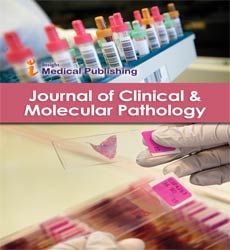ISSN : 2634-7806
Journal of Clinical and Molecular Pathology : Open Access
Understanding Molecular Pathology of Prostate Cancer
Adeola Musa*
Department of Pathology, University of IbadanIbadan, Ibadan, Nigeria
- *Corresponding Author:
- Adeola Musa
Department of Pathology, University of IbadanIbadan, Ibadan, Nigeria
E-mail: adeola-musa@gmail.com
Received Date: December 09, 2021; Accepted Date: December 23, 2021; Published Date: December 30, 2021
Citation: Musaa A (2021) Understanding Molecular Pathology of Prostate Cancer. J Clin Mol Patho Vol.5 No.4
Description
Prostate cancer is common, and recent efforts in the clinical management have focused more on identifying the patients who could be candidates from the less aggressive management or who could benefit from the more aggressive therapy. Prostate cancer is the second leading cause of cancer deaths in particularly in men. As prostate cancer histology, especially Gleason Score plays an important role in predicting the patient outcomes, attempts have been made to refine the histologic classification and reporting in prostate cancer to facilitate the patient risk stratification. Over the years, several models have been developed so far and were found to be very helpful in understanding the biology of the prostate cancer. Biological research relies merely on the in-vitro and in-vivo models which can be used to examine the gene functions and responses to the external agents in the laboratory and preclinical settings.
Prostate cancer afflicts the one man mostly in the nine over the age of 65. Early detection through the serum testing for Prostate Specific Antigen (PSA) and improved procedures for the surgical intervention and radiation therapy have significantly reduced the number of fatalities. However, there is still no effective cure for men with the advanced disease. Therefore, much research has been made and dedicated in identifying the prognostic markers which mainly distinguish the indolent versus aggressive forms of the prostate cancer. In contrast, significantly less research has been devoted in understanding the molecular mechanisms that mainly underlie the normal prostate growth and the development or cancer initiation and progression. Development of any type of cancer reflects a progressive accumulation of alterations in the various genes. Oncogenes, tumour suppressor genes, DNA repair genes and metastasis suppressor genes have been investigated in the prostate cancer.
Prostate cancer is particularly the heterogeneous and the multifocal, with the diverse clinical and the morphologic manifestations. The current understanding of the molecular basis for this heterogeneity is limited, particularly for the Prostatic Intraepithelial Neoplasia (PIN), the only putative precursor that can be identified according to the criteria of morphologic. It is conceivable that a stem cell of basal phenotype or an amplifying cell is the target for the prostatic carcinogenesis. Prominent genetic heterogeneity is the main characteristic of both PIN and carcinoma; and multiple foci of PIN arises independently within the the same prostate. Multiple foci of the cancer also often arise independently, that lends additional support to this hypothesis. The strong genetic similarities between the PIN and the cancer suggest that the evolution and clonal expansion of PIN, or other the precursor lesions, may account for the multifocal etiology of further carcinoma. Uncertainties with respect to the identifying of those precursor lesions that are likely to progress to invasive and the metastatic prostate cancer reinforce the requirement for objective immunehistochemical or the molecular biological markers of the aggressive phenotype.
Conclusion
The molecular basis of the prostate cancer includes inheritable and somatic genetic changes (tumour suppressor genes, loss of heterozygosity, gene targets and regions of the chromosomal gain, CpG is land promoter methylation, invasion and the metastasis suppressor genes, telomere shortening, and the genetic instability). Changed gene expression (e.g.proliferation-related genes, changes in the androgen receptor, apoptosis and the stress-response genes) have potential as biomarkers and the therapeutic targets in prostate cancer.
Open Access Journals
- Aquaculture & Veterinary Science
- Chemistry & Chemical Sciences
- Clinical Sciences
- Engineering
- General Science
- Genetics & Molecular Biology
- Health Care & Nursing
- Immunology & Microbiology
- Materials Science
- Mathematics & Physics
- Medical Sciences
- Neurology & Psychiatry
- Oncology & Cancer Science
- Pharmaceutical Sciences
